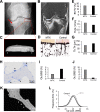Clinical and Radiological Characterization of Patients with Immobilizing and Progressive Stress Fractures in Methotrexate Osteopathy
- PMID: 33064170
- PMCID: PMC7819927
- DOI: 10.1007/s00223-020-00765-5
Clinical and Radiological Characterization of Patients with Immobilizing and Progressive Stress Fractures in Methotrexate Osteopathy
Abstract
Methotrexate (MTX) is one of the most commonly prescribed drugs for autoimmune rheumatic diseases. As there is no consensus on its negative effects on bone, the purpose of this investigation was to determine the clinical spectrum of patients with stress fractures due to long-term MTX treatment (i.e., MTX osteopathy). We have retrospectively analyzed data from 34 patients with MTX treatment, severe lower extremity pain and immobilization. MRI scans, bone turnover markers, bone mineral density (DXA) and bone microarchitecture (HR-pQCT) were evaluated. Stress fractures were also imaged with cone beam CT. While the time between clinical onset and diagnosis was prolonged (17.4 ± 8.6 months), the stress fractures had a pathognomonic appearance (i.e., band-/meander-shaped, along the growth plate) and were diagnosed in the distal tibia (53%), the calcaneus (53%), around the knee (62%) and at multiple sites (68%). Skeletal deterioration was expressed by osteoporosis (62%) along with dissociation of low bone formation and increased bone resorption. MTX treatment was discontinued in 27/34 patients, and a combined denosumab-teriparatide treatment initiated. Ten patients re-evaluated at follow-up (2.6 ± 1.5 years) had improved clinically in terms of successful remobilization. Taken together, our findings provide the first in-depth skeletal characterization of patients with pathognomonic stress fractures after long-term MTX treatment.
Keywords: Cone beam CT; Denosumab; MTX osteopathy; Methotrexate; Stress fracture; Teriparatide.
Conflict of interest statement
Tim Rolvien, Nico Maximilian Jandl, Julian Stürznickel, Frank Timo Beil, Ina Kötter, Ralf Oheim, Ansgar W Lohse, Florian Barvencik and Michael Amling declare that they have no conflict of interest.
Figures






Similar articles
-
Stress fractures in systemic lupus erythematosus after long-term MTX use successfully treated by MTX discontinuation and individualized bone-specific therapy.Lupus. 2019 May;28(6):790-793. doi: 10.1177/0961203319841434. Epub 2019 Apr 4. Lupus. 2019. PMID: 30947618
-
Clinical features of methotrexate osteopathy in rheumatic musculoskeletal disease: A systematic review.Semin Arthritis Rheum. 2022 Feb;52:151952. doi: 10.1016/j.semarthrit.2022.151952. Epub 2022 Jan 10. Semin Arthritis Rheum. 2022. PMID: 35038641
-
Methotrexate osteopathy: five cases and systematic literature review.Osteoporos Int. 2021 Feb;32(2):225-232. doi: 10.1007/s00198-020-05664-x. Epub 2020 Oct 30. Osteoporos Int. 2021. PMID: 33128074
-
Atypical fractures of the lower extremities in two patients with rheumatoid arthritis: clinical presentations of presumed methotrexate osteopathy.BMJ Case Rep. 2024 Aug 31;17(8):e256567. doi: 10.1136/bcr-2023-256567. BMJ Case Rep. 2024. PMID: 39216879
-
MTX Osteopathy Versus Osteoporosis Including Response to Treatment Data-A Retrospective Single Center Study Including 172 Patients.Calcif Tissue Int. 2024 Nov;115(5):599-610. doi: 10.1007/s00223-024-01290-5. Epub 2024 Sep 25. Calcif Tissue Int. 2024. PMID: 39322780 Free PMC article.
Cited by
-
Bone stress injuries.Nat Rev Dis Primers. 2022 Apr 28;8(1):26. doi: 10.1038/s41572-022-00352-y. Nat Rev Dis Primers. 2022. PMID: 35484131 Review.
-
Influence of X-rays and gamma-rays on the mechanical performance of human bone factoring out intraindividual bone structure and composition indices.Mater Today Bio. 2021 Nov 26;13:100169. doi: 10.1016/j.mtbio.2021.100169. eCollection 2022 Jan. Mater Today Bio. 2021. PMID: 34927043 Free PMC article.
-
The Effect of Anti-rheumatic Drugs on the Skeleton.Calcif Tissue Int. 2022 Nov;111(5):445-456. doi: 10.1007/s00223-022-01001-y. Epub 2022 Jun 30. Calcif Tissue Int. 2022. PMID: 35771255 Free PMC article. Review.
-
[Clavicle stress fracture following reverse shoulder arthroplasty].Orthopade. 2022 Mar;51(3):246-250. doi: 10.1007/s00132-021-04205-6. Epub 2022 Jan 6. Orthopade. 2022. PMID: 34989823 Free PMC article. German.
-
Bone marrow edema in children: chronic nonbacterial osteomyelitis and its mimickers.Ther Adv Musculoskelet Dis. 2024 Sep 18;16:1759720X241278438. doi: 10.1177/1759720X241278438. eCollection 2024. Ther Adv Musculoskelet Dis. 2024. PMID: 39314820 Free PMC article. Review.
References
-
- Constantin A, Loubet-Lescoulie P, Lambert N, Yassine-Diab B, Abbal M, Mazieres B, de Preval C, Cantagrel A. Antiinflammatory and immunoregulatory action of methotrexate in the treatment of rheumatoid arthritis: evidence of increased interleukin-4 and interleukin-10 gene expression demonstrated in vitro by competitive reverse transcriptase-polymerase chain reaction. Arthritis Rheum. 1998;41:48–57. - PubMed
-
- Wessels JA, Huizinga TW, Guchelaar HJ. Recent insights in the pharmacological actions of methotrexate in the treatment of rheumatoid arthritis. Rheumatology (Oxford) 2008;47:249–255. - PubMed
-
- Schwartz AM, Leonidas JC. Methotrexate osteopathy. Skelet Radiol. 1984;11:13–16. - PubMed
MeSH terms
Substances
LinkOut - more resources
Full Text Sources
Medical
Research Materials

